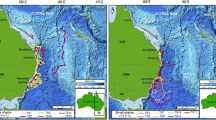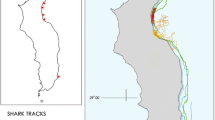Abstract
Archival tags were used to study the movement and depth behaviour of school sharks, Galeorhinus galeus, in southern australia. Thirty fish were tagged in late 1997, and to date there have been nine recaptures (30% recapture rate). Periods at liberty varied from 8 days to 18 months. The sharks spent about 80% of their time on the continental shelf, and appeared to swim close to the bottom during the day. At night they often ascended for periods of up to several hours, except at times around the full moon. When in deep water, the sharks typically descended at dawn to depths of up to 600 m, before ascending at dusk. It was not possible to use the light data from the tags to estimate position when the sharks were in deep water, because they were often at depths beyond the sensitivity of the tag. In shallower water, longitude was estimated from the light data but latitude was estimated from the maximum daily depth, assuming the fish were on the bottom. The timing of the dives in deepwater appeared sufficiently regular to offer the prospect of using it to estimate longitude. We propose future research using archival tags on this species should address questions about female reproductive migrations, pelagic behaviour and vertical movements.
Similar content being viewed by others
References
Block, B.A., H. Dewar, T. Williams, E.D. Prince, C. Farwell & D. Fudge. 1998. Archival tagging of Atlantic bluefin tuna (Thunnus thynnus thynnus). Marine Technology Society Journal 32: 37–46.
Block, B.A., D.T. Booth & F.G. Carey. 1992. Depth and temperature of the blue marlin, Makaira nigricans, observed by acoustic telemetry. Mar. Biol. 114: 175–183.
Carey, F.G. & B.H. Robinson. 1981. Daily patterns in the activities of swordfish, Xiphius gladius, observed by acoustic telemetry. U.S. Fish. Bull. 79: 277–292.
Carey, F.G., J.W. Kanwisher, O.B. Brazier, G. Gabrielson, J.G. Casey & H.L. Pratt, Jr. 1982. Temperature and activities of a white shark, Carcharodon carcharias. Copeia 1982: 254–260.
Carey, F.G. & J.V. Scharold. 1990. Movements of blue sharks (Prionace glauca) in depth and course. Mar. Biol. 106: 329–342.
Compagno, L.J.V. 1984. FAO species catalogue. Vol. 4, Sharks of the world. Annotated and illustrated catalogue of the shark species known to date. FAO Fisheries Synopsis, Part 2 - Carcharhiniformes: i- x, 251–655.
DeLong, R.L., B.S Stewart & R.D Hill. 1992. Documenting migrations of northern elephant seals using day-length. Marine Mammal Science 8: 155–159.
Gunn, J.S., T. Polacheck, T.L.O. Davis, M. Sherlock & A. Betlehem. 1994. The development and use of archival tags for studying the migration, behaviour and physiology of southern bluefin tuna, with an assessment of the potential for transfer of the technology to groundfish research. ICES C.M. Mini Symposium on Fish Migration 2.1. 22 pp.
Gunn, J.S., J.D. Stevens, T.L.O. Davis & B. Norman. 2000. Observations on the short-term movements and behaviour of whale sharks (Rhincodon typus) at Ningaloo Reef,Western Australia. Mar. Biol. (in press).
Hill, R.D. 1994. Theory of geolocation by light levels. pp. 227–236. In: B.J. Boeuf & R.M. Laws (ed.) Elephant Seals, Population Ecology, Behaviour and Physiology, Uni. Calif. Press, Berkeley.
Holden, M.J. & R.G. Horrod. 1979. The migrations of tope, Galeorhinus galeus (L), in the eastern North Atlantic as determined by tagging. J. Cons. int. Explor. Mer 38: 314–317.
Holland, K.N., R.W. Brill & R.K.C. Chang. 1990a. Horizontal and vertical movements of yellowfin and bigeye tuna associated with fish aggregating devices. U.S. Fish. Bull. 88: 493–507.
Holland, K.N., R.W. Brill & R.K.C. Chang. 1990b. Horizontal and vertical movements of Pacific blue marlin captured and released using sportfishing gear. U.S. Fish. Bull. 88: 397–402.
Holland, K.N., R.W. Brill, R.K.C. Chang, J.R. Sibert & D.A. Fournier. 1992. Physiological and behavioural thermoregulation in bigeye tuna (Thunnus obesus). Nature 358: 410–412.
Holland, K.N. & J.R. Sibert. 1994. Physiological thermoregulation in bigeye tuna, Thunnus obesus. Env. Biol. Fish. 40: 319–327.
Holts, D.B. & D.W. Bedford. 1993. Horizontal and vertical movements of the shortfin mako shark, Isurus oxyrinchus, in the southern California Bight. Aust. J. Mar. Freshw. Res. 44: 901–909.
Hunter, J.R., A.W. Argue, W.H. Bayliff, A.E. Dizon, A. Fonteneau, D. Goodman & G.R. Seckel. 1986. The dynamics of tuna movements: an evaluation of past and future research. FAO Fish. Tech. Pap. 277. 78 pp.
Hurst, R.J., N.W. Bagley, G.A. McGregor & M.P Francis. 1999. Movements of the New Zealand school shark, Galeorhinus galeus, from tag returns. N.Z J. Mar. Freshw. Res. 33: 29–48.
Klimley, A.P. 1993. Highly directional swimming by scalloped hammerhead sharks, Sphyrna lewini, and subsurface irradiance, temperature, bathymetry, and geomagnetic field. Mar. Biol. 117: 1–22.
Last, P.R. & J.D. Stevens. 1994. Sharks and rays of Australia. CSIRO, Canberra. 513 pp.
Metcalfe, J.D. & G.P. Arnold. 1997. Tracking fish with electronic tags. Nature 387: 665–666.
Nakamura, Y. 1993. Vertical and horizontal movements of mature females of Ommastrephes bartramii observed by ultrasonic telemetry. pp. 331–336. In: T. Okutani, R.K. O'Dor & T. Kubodera (ed.) Recent Advances in Fisheries Biology, Tokai Univ. Press, Tokyo.
Nelson, D.R. 1990. Telemetry studies of sharks: a review, with applications in resource management. pp. 239–256. In: H.L. Pratt, S.H. Gruber & T. Taniuchi (ed.) Elasmobranchs as Living Resources: Advances in the Biology, Ecology, Systematics, and the Status of the Fisheries, U.S. Dep. Commer., NOAA Tech. Rep. NMFS 90.
Nelson, D.R., J.N. McKibben, W.S. Strong, Jr., C.G. Lowe, J.A. Sisneros, D.M. Schroeder & R.J. Lavenberg. 1997. An acoustic tracking of a megamouth shark, Megachasma pelagios: a crespuscular vertical migrator. Env. Biol. Fish. 49: 389–399.
Nowara, G.B. & T.I. Walker. 1998. Effects of time of solar day, jigging method and jigging depth on catch rates and size of Gould's squid, Nototodarus gouldi (McCoy), in southeastern Australian waters. Fisheries Research 34: 279–288.
Olsen, A.M. 1954. The biology, migration and growth rate of the school shark, Galeorhinus australis (Macleay) (Carcharhinidae) in south-eastern Australian waters. Aust. J. Mar. Freshw. Res. 5: 353–410.
O'sullivan, D. & J.M. Cullen. 1983. The food of the squid Notodarus gouldi in Bass Strait. Aust. J. Mar. Freshw. Res. 34: 261–285.
Pepperell, J.G. & T.L.O. Davis. 1999. Post-release behaviour of black marlin, Makaira indica, caught off the Great Barrier Reef with sportfishing gear. Mar. Biol. (in press).
Punt, A.E. & T.I. Walker. 1998. Stock assessment and risk analysis for the school shark (Galeorhinus galeus) resource off southern Australia. Mar. Freshw. Res. 49: 719–731.
Sciarrotta, T.C. & D.R. Nelson. 1997. Diel behavior of the blue shark, Prionace glauca, near Santa Catalina Island, California. U.S. Fish. Bull. 75: 519–528.
Stewart, B.S. & R.L. DeLong. 1995. Double migrations of the northern elephant seal, Mirounga augustirostris. Journal of Mammology 76: 196–205.
Tricas, T.C. 1979. Relationships of the blue shark, Prionace glauca, and its prey species near Santa Catalina Island, California. U.S. Fish. Bull. 77: 175–182.
Welch, D.W. & J.P. Eveson. 1999. An assessment of light-based geoposition estimates from archival tags. Can. J. Fish. Aquat. Sci. 56: 1317–1327.
Wilson, R.P., J.J. Ducamp, W.G. Rees, B.M Culik & K. Niekam. 1992. Estimation of location: global coverage using light intensity. pp. 131–135. In: I.G. Priede & S.M. Swift (ed.) Wildlife Telemetry: Remote Monitoring and Tracking of Animals, Ellis Horwood, Chichester.
Wilson, R.P., K. Puetz, J.-B. Charrassin & J. Lage. 1995. Artifacts arising from sampling interval in dive depth studies of marine endotherms. Polar Biology 15: 575–581.
Author information
Authors and Affiliations
Rights and permissions
About this article
Cite this article
West, G.J., Stevens, J.D. Archival Tagging Of School Shark, Galeorhinus Galeus, in Australia: Initial Results. Environmental Biology of Fishes 60, 283–298 (2001). https://doi.org/10.1023/A:1007697816642
Issue Date:
DOI: https://doi.org/10.1023/A:1007697816642




